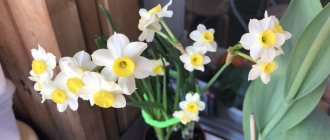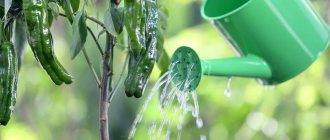Azalea is one of the most unpretentious plants in terms of care and maintenance. It requires proper lighting, fertilizing, and a certain degree of humidity. It is necessary to properly water the azalea so that the flowers and vegetative mass remain fresh and do not fade. If you follow step-by-step steps and use only the right water, then problems should not arise.
A voluminous azalea bush grown under the right conditions
Methods of supplying water for flower growth
There are 3 optimal methods for watering azaleas, which help moisten the soil and nourish the rhizome, but not damage the buds.
- Through the pallet. Water is poured into the pan, after which it goes into the soil. The technique is carried out gradually, according to the need for liquid to nourish the root and the entire flower. This method reduces the risk of root rot.
- Above. The liquid is poured into the soil through a watering can. This must be done with caution so that water does not fall directly on the buds. It should extend to the root collar area. There should be an empty tray under the flower so that excess liquid comes out there and does not linger. Otherwise, root rot may occur.
- Immersion in a container of water. Water is poured into the container and the flower is placed there. Wait 20-30 minutes until it is saturated with liquid. Then they take out the bush and wait until the water drains. This method helps a plant that has not been watered for a long time, which is why it has begun to wither. However, this technique can be performed no more than once a week, so as not to overwater the plant.
Only the top layer of soil should always remain moist. It is unacceptable to overwater the plant, otherwise rot will begin to develop in the area of the root collar, penetrating deeper and deeper.
Root watering, prohibiting water from entering the buds
Consequences of an incorrectly performed procedure
The difficulty of watering azaleas lies in the fact that, on the one hand, it requires a lot of moisture - and on the other, waterlogging can lead to disease and rotting. Plant disease can also be caused by inappropriate (for example, too hard or icy) water.
Azalea is a very capricious and demanding plant. Therefore, it is important to follow all care recommendations. We recommend reading our articles on methods of propagating and pruning flowers.
How to deal with the problems that have arisen?
Excessive flooding of the soil deprives the roots of an influx of oxygen and creates conditions for the development of pathogenic microflora. Externally, this is reflected on the plant in the falling of flowers and leaves, the bush withers and eventually dies. It is very difficult to save such a plant; it is easier to separate its more or less living part and start growing it again.
As for drying, it is quite possible to solve this problem. A flower with a dried earthen braid is immersed in water for an hour, after which it is planted in fresh soil. The next watering is carried out in 2-3 days, further irrigation is carried out according to the rules discussed above.
You can find out why azalea leaves dry out and fall off and how to save them here.
By observing all these subtleties and carefully monitoring the condition of the plant, you can get at your disposal a full-fledged healthy azalea, which will annually delight the owner with beautiful, rich, abundantly blooming flowers framed by dark leaves. Don’t be afraid to start this shrub, because with experience comes ease of maintenance. And its whimsicality is fully justified by its amazing flowering.
How often?
To ensure that growth occurs evenly and the bush does not fade, it is important to find out how often to water the azalea. The florist should adhere to the following recommendations:
- in summer, the flower is watered 2-3 times a week, during this period active growth and formation of buds begins, so the soil should always be moist;
- if there is an elevated temperature of more than 30 degrees and severe drought, it is permissible to water the flower 4-5 times a week;
- In winter, the amount of watering is reduced to once a week.
Even if there is a severe drought, you can only water, without spraying. Such irrigation has a negative effect on the vegetative mass and buds; the flowers will no longer hold their shape.
Feeding azaleas
Azaleas are fertilized every two weeks with mineral fertilizers. During the period of bud formation, it is recommended to use “Superphosphate” in a concentration of 15 g per 10 liters of water. The ideal option when feeding a flower is to use a special Azalea fertilizer, which is sold in flower shops. There are also a number of fertilizers that promote the growth and flowering of azaleas. During the period of bud formation, to accelerate flowering, use a fertilizer containing large amounts of phosphorus and potassium - “Uniflor-bud” and “Kemira-lux”.
After flowering, during the growing season, use a fertilizer containing nitrogen - “Uniflor-micro”. A good tool for feeding, stimulating flowering, and root growth would be “Zircon” - a growth stimulator based on plant raw materials. Sold in all flower shops in plastic containers. The drug is highly economical (1-2 drops per 20 liters of water). Be sure to read the instructions for use! Azalea will not forgive you for an overdose! A very important fertilizing “Iron chelate (ferovit)” is applicable when the azalea’s leaves begin to turn yellow due to lack of iron. Iron chelate - soluble powder, proportion (5g per 10 liters) when used. Be sure to read the instructions for use!
Atmospheric humidity and increase in this indicator
Azalea likes humidity to be above average. Typically the figure should be 60-70%. It may decrease at excessively high temperatures or when heating appliances are turned on in winter. To normalize it, the following methods are used:
- connecting an air humidifier, which is located away from the flower so that the steam does not directly spread to the flowers;
- the location of the pan with water, from which the water gradually evaporates into the air;
- placement of wet towels on radiators.
If the air in the room is not dry, it is not recommended to humidify it. It is enough to carry out periodic watering. This moisture is enough to maintain the elasticity of the vegetative mass.
Eliminating dryness with a humidifier
From the history of azalea
Azalea was discovered in the late eighteenth and early nineteenth centuries in England. During his travels, the Dutch scientist Brainius discovered a plant that amazed him with its beauty; the bush strewn with fabulously beautiful flowers left him no choice. He brought it to his homeland, but after a short period the plant did not take root and died. Some time later, another traveler and scientist Conners attempted to tame the azalea, but also unsuccessfully; the bush could not withstand the move and also died.
Only at the very beginning of the nineteenth century did Captain Welbank bring from India the first specimen of azalea that managed to survive. After which this specimen became the ancestor of a great variety of hybrids and varieties. The work done by botanical scientists cannot be overestimated, because their long-term selection work contributed to the birth of this beautiful evergreen shrub, which pleases us with its lush flowering at a time when most plants are in a period of “hibernation”.
Selecting water for irrigation
When watering azaleas at home, you need to carefully select the quality of water. It should not be hard or contain a large amount of foreign substances. It is better to use water that meets the following qualities:
- pre-cleaned, filtered;
- does not contain foreign impurities;
- room temperature (it should not be cold or hot).
The following types of water are recommended for watering a flower:
- rain;
- filtered;
- settled;
- bottled;
- infused with peat (it absorbs foreign substances and at the same time releases beneficial microelements).
If the user buys bottled water, first read its composition. It should not be distilled, since in such a liquid all microelements are completely destroyed, the liquid loses its functionality and usefulness.
Azalea loves slightly acidified water. Therefore, after receiving the purified liquid, add a small amount of lemon juice to reduce the acid-base state. This will prevent alkalization of the nutrient soil and normalize its Ph.
Filtering water before watering
What to irrigate with?
The composition of the liquid is very important for the fastidious azalea . Hard water is unacceptable for it, as is heavily chlorinated tap water: rhododendron prefers acidified soil, and this type of watering leads to the formation of an alkaline environment. The ideal option is rain or melt water. In the absence of such, you can use boiled or filtered tap water, but it is better to first let it sit for a couple of days.
Since an acidified environment for azaleas is necessary for healthy growth, it is recommended to add half a teaspoon of citric acid to one liter of water once a month. This will not only maintain the pH of the soil, but will also soften the water itself.
Another way to soften is to infuse with peat. The calculation is made in the format of one and a half handfuls per five liters, one night is enough to complete the process.
Temperature
When a florist figures out how to water an azalea correctly, they learn about the temperature of the water. It is characterized by the following conditions:
- prohibition on excessively cold or hot watering;
- choosing a liquid at room temperature (about 20-25 degrees).
To get the water to the desired temperature, it is enough to keep it at room conditions for several hours. If watering needs to be done immediately, but it is still cold, you can add a small portion of boiling water.
Heating water in the microwave is not recommended, otherwise some of the beneficial microelements will be destroyed.
Also important for azalea is the temperature regime of the air, depending on the cycle:
- in spring and summer (the period of active vegetation and growth) - maintain the temperature within +20...+24 degrees;
- in autumn and winter (the plant goes into dormant mode and slows down its vital activity) - +16...+19 degrees.
Reducing the temperature to less than 16 degrees is prohibited; this will lead to the death of stems and leaves.
Flowering period
Flowering begins in the third or fourth year of life. Indoor specimens bloom magnificently and beautifully. The flowers have a rich pink hue. But there are also bright red, lilac, snow-white, violet. Bicolor plants are less common. Flower petals can be even, slightly double or double. The foliage plates are relatively small in size.
Features of caring for a houseplant
In order for flowering to be active, the vegetative mass grows quickly; in addition to watering, other care conditions must be observed:
- lighting - the flower pot is placed under diffused sunlight, direct light should not fall on it, otherwise a burn will occur;
- fertilizers - from the moment of flowering, preparations for decorative flowering varieties are applied, but the prescribed proportions are halved; an increased dosage can lead to burns of the rhizome;
- replanting - a perennial flower needs to be replanted every year at a young age, once every 3 years as an adult;
- quality of the pot - small in size, light (to prevent overheating), with a drainage hole to allow excess liquid to escape,
- humidity - within 60-70%, but not higher than this parameter, otherwise the buds will begin to fade;
- propagation - propagation is available by root division, cuttings, seeds (the latter option is complex and rarely sprouts, so it is better to use root division or cuttings).
If you follow the prescribed recommendations after purchasing a plant, it will delight the grower every growing season with an abundance of buds.
Caring for your home azalea
Reproduction
Azaleas are propagated at home by cuttings. Basically, cuttings are prepared in the warm season. The cuttings are prepared as follows: the semi-lignified shoot should be about 10 cm in length.
The undercut is made under the lower bud. The lower leaves should be completely cut off. And the rest are shortened by half. Then the cuttings must be placed at the cut site in Kornevin’s solution.
After 7 hours, the petioles need to be planted in a small vessel with nutrient soil. To quickly root cuttings, it is recommended to use special heating.
The cuttings need to be given appropriate care: water them daily and provide regular ventilation. Remember that young plants must be watered with settled water. When the cuttings take their first roots, they need to be moved to new containers filled with coniferous soil. 8 weeks after transplantation, it is recommended to pinch the cuttings, thanks to this you can form a magnificent bush.
Transplanting azalea
Transplanting azaleas should only be done when absolutely necessary. You can replant only once a year if the plant is not yet 3 years old, and twice a year if the plant is older. The reason for replanting an azalea can be a heavily overgrown root system that tightly envelops the substrate or rotting of the substrate with all sorts of formations on the surface. After purchasing an azalea in a store, try not to replant the flower for as long as possible. Give the flower time to adapt to new conditions.
When replanting azaleas, use special soil for rhododendrons.
Where and how much can you buy rhododendron?
Indoor varieties of Rhododendron are a frequent guest on the shelves of flower shops, so purchasing a miniature shrub for your collection will not be difficult .
You can choose a suitable plant either in one of the commercial outlets in the city, or directly from the manufacturer, at a thematic exhibition, or “from hand”, having studied numerous offers on private advertisement sites on the Internet.
Check out the photo of the azalea purchased in the store:
What water and how to water the azalea - a favorite of gardeners: all the nuances of the procedure
Azalea is one of the favorite shrubs among gardeners and flower growers. Despite the relative whimsical nature of cultivation, this plant from the rhododendron genus is gaining more and more popularity every year. And if you correctly take into account all the factors of care, then its lush flowering will invariably and regularly please the eye.
And since maintaining a certain type of illumination or temperature often does not cause problems, a gardener who is seriously thinking about purchasing an azalea should pay close attention to the theory of watering, which is so important for this shrub.
Lighting
The main feature of Azalea lighting is due to the fact that it does not like heat. In its natural environment, it thrives in shady places where there is enough light, but where direct sunlight simply cannot penetrate.
Azalea loves light, but can't stand heat
Therefore, it is desirable to recreate the same conditions in an artificial environment.
- It is necessary to find a place where there will be enough light, but where the sun will either not look at all, or only hit in the morning or evening hours.
- The same can be said about those situations when Azalea is taken out into the open air. For example, at the dacha, the plant can be left in a shaded place under the trees in the garden, where the aggressive midday sun will not reach.
- At the same time, Azalea will not have enough light in October-November, when the buds of future flowers are set. Then you can’t do without fluorescent lamps.
We can say that Azalea is demanding in terms of lighting and is most capricious in this aspect. Therefore, finding a suitable place can be problematic, but it must be done.
Choosing a place to put it
Azalea on a table in the back of the room
When the question of choosing a place for Azalea arises, the intensity of sunlight should be put first, and only then the temperature.
The flower will feel good on windowsills where there is little sun. For example, windows facing west or east would be an ideal option. Usually the rays of the rising or setting sun cannot harm the delicate leaves of the plant.
You'll also have to think about temperature. It is true that even a slight discomfort that an Azalea will experience due to too high or too low a temperature will definitely lead to less than ideal and less long-lasting blooms.
Therefore, it is better to give preference to well-ventilated, shady rooms. It is very good if there is air conditioning in the room.
The balcony is also well suited for this heat-loving flower. But only if it does not face the south side.
Azalea on the windowsill
What does it look like in the interior?
Azalea belongs to the genus Rhododendron, which literally translates as “rose tree”. This is the distinctive feature of Azaleas - bright flowers of pink or red.
Externally, this plant is a neat bush that rarely exceeds 50 centimeters in height. Because Azaleas have very small leaves, they are almost invisible when the flowers bloom, occupying most of the plant's volume.
Undoubtedly, Azaleas will decorate a balcony or a not very hot window sill, because during their flowering season, when there is snow outside, they will remind you of the imminent approach of the long-awaited spring.











